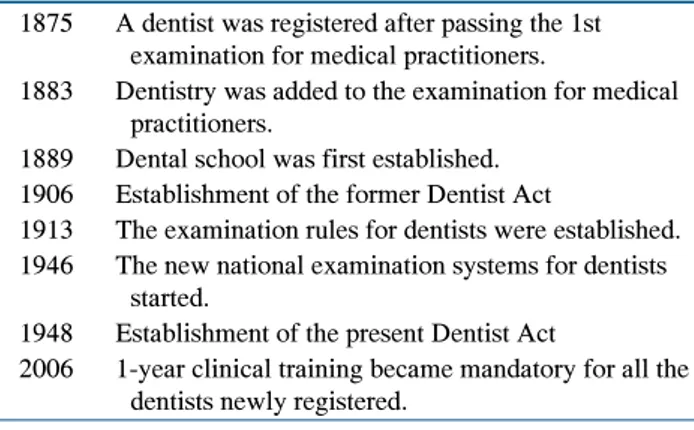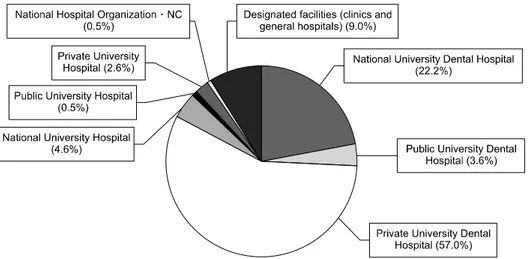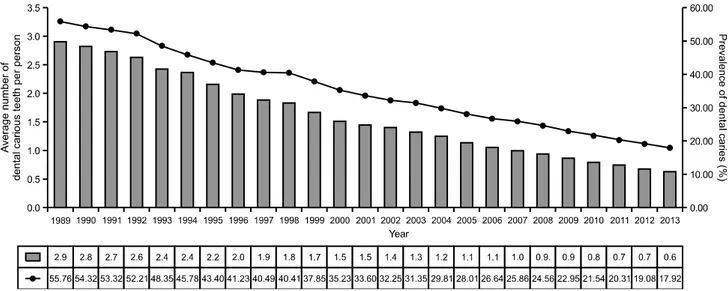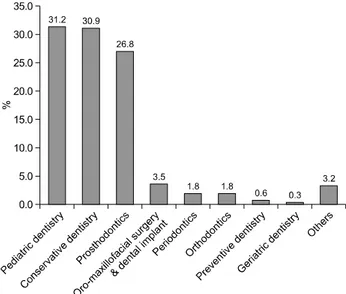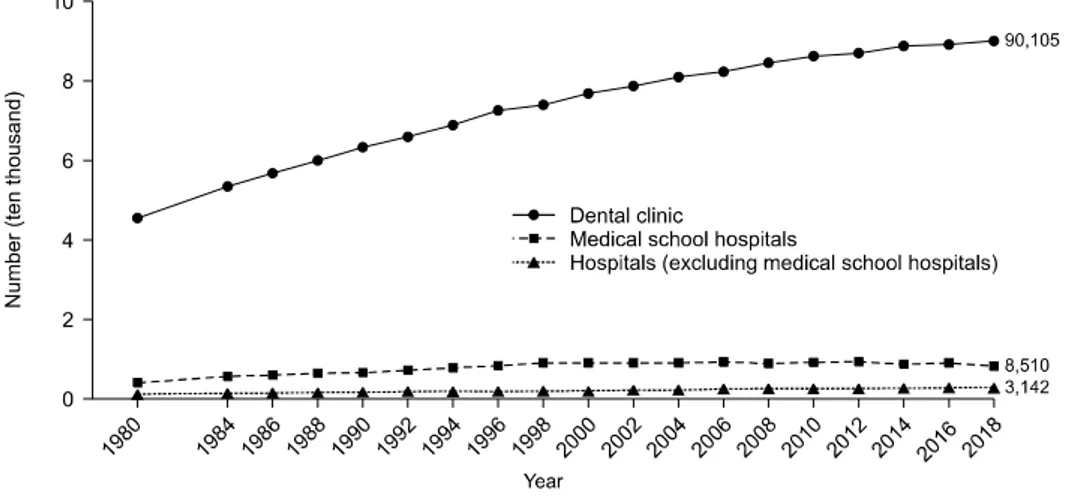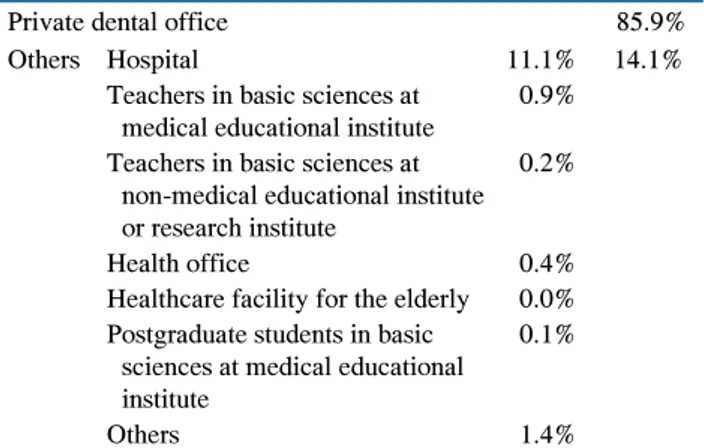REVIEW ARTICLE
Received: February 25, 2021, Revised: March 5, 2021, Accepted: March 13, 2021 eISSN 2233-7679
†Correspondence to:
Sang-Hwan Oh, https://orcid.org/0000-0002-5944-0129
Department of Dental Hygiene, College of Medical Science, Konyang University, Gwanjeodong-ro 158, Daejeon 35365, Korea Tel: +82-42-600-8447, Fax: +82-42-600-8406, E-mail: dentsh27@konyang.ac.kr
Copyright © The Korean Society of Dental Hygiene Science.
The Past and Current Status of Dentists in Japan
Masaru Sugiyama
1, Rumi Nishimura
2, Myung-Jin Lee
3, and Sang-Hwan Oh
4,†1
Graduate School of Biomedical and Health Sciences, Hiroshima University, Hiroshima 734-8553, 2Department of Oral Epidemiology, Graduate School of Biomedical and Health Sciences, Hiroshima University, Hiroshima 734-8553, Japan, 3Department of Dental Hygiene, Division of Health Science, Baekseok University, Cheonan
31065, 4Department of Dental Hygiene, College of Medical Science, Konyang University, Daejeon 35365, Korea
The purpose of this study is to provide the general history of fostering dentists in Japan and introducing their new roles. This research was conducted based on the government policy report on dentists and the information published by each educational institution. Based on the collected data, the official websites were used to represent the latest statistics of the institutions. The number of dentists in Japan has increased. The government established the National Examination for Dentists to guarantee the quality of dentists. After the standards for developing questions for the national examination were established in 1985, the contents of the examination have been appropriately improved by revising the standards every four years. This improvement has required dental students to study a variety of subjects for six years at dental school. Since dentists in Japan are required to respond to various demands from the nation; the Model Core Curriculum for Dental Education was developed to teach medical ethics and abilities to ensure that dentists conduct themselves professionally. Recently, the roles of dentists have been changing in Japan. When providing dental services to older patients over the age of 65, dentists and other dental professions focus on maintaining oral functions, such as saliva secretion, bite force, tongue movement, and masticatory/swallowing functions. However, oral function-related services for children are different. In addition to providing essential dental services, dental practitioners also provide special treatment, such as oral muscle training, myofunctional therapy, health guidance, and space retainers to the child patients with developmental insufficiency in oral functions. Dentistry in Japan has undergone numerous changes over the years and has continued to offer high-quality dental health services. Thus, information gained from the Japanese experience may be helpful to dental professions in other developed countries for planning oral health measures.
Key Words: Curriculum, Dentist, Japan, National examination, Work place, Work role
Introduction
After the Meiji Restoration in 1986, Japanese pioneers studied dentistry from American dentists and introduced
modern dentistry into Japan1). Soon after World War II, a
variety of reforms led to the establishment of the new Dentist Act and the Dental Hygienist Act under the direction of the General Head Quarters of the Allied
Forces2). The Ministries of Education and Health
sub-sequently strived to improve the nation’s oral health by fostering well-trained dental professions, establishing good medical care systems, and so on. As a result, the
percentage of children with decayed teeth has significantly decreased and the elderly ≥80 years with ≥20 teeth have
also increased remarkably3). Recently, in Japan, maintaining
and improving a variety of oral functions throughout the patient’s lifespan has been recognized as an important consideration for lifelong health4,5).
This study aimed to provide some useful information for dental professions seeking better dental education and dental care systems by discussing the status of dentists in Japan and in particular, focusing on the dental education system and the roles of dentists.
Table 1. History of Fostering Dentist in Japan1) 1875 A dentist was registered after passing the 1st
examination for medical practitioners.
1883 Dentistry was added to the examination for medical practitioners.
1889 Dental school was first established. 1906 Establishment of the former Dentist Act
1913 The examination rules for dentists were established. 1946 The new national examination systems for dentists
started.
1948 Establishment of the present Dentist Act
2006 1-year clinical training became mandatory for all the dentists newly registered.
History of Fostering Dentists in Japan
The Japanese history of dentists is summarized in Table
1. The first Japanese dentist was Mr. Einosuke Obata. He
studied dentistry under an American dentist who came to
Japan1). Subsequently, Mr. Obata passed the examination
for medical practitioners which was first conducted in 1875, and he registered as a medical doctor who specialized in dentistry. He devotedly taught dentistry to the younger generations but he did not establish an educational institution for dentistry. In 1883, the examination rules for medical practitioners were established and dentistry was added). Since then, passing this examination has been mandatory to become a dentist. The registration system of authorized dentists began at the same time.
The first Japanese dental school, Takayama Dental School, was established in 1889 by Mr. Kisai Takayama
who studied dentistry in the US1). That school is presently
named Tokyo Dental College. Mr. Takayama also wrote a Japanese study guide for dentistry.
In 1903, the former Japan Dental Association was established and in 1096, the former Dentist Act was
established1). Since then, eight dental schools were
established until the end of World War II1). In 1913, examination rules specifically for dentists were established. These rules prescribed that examinees must have studied
for more than three years at a dental school1).
In 1946, one year after the war ended, the new national examination systems for medical doctors, dentists, and pharmacists commenced, while the new Dentist Act was
established in 19481). The new examination system
required the examinees to have studied for more than six years at a dental school. To address the shortage of dentists at the time, dental schools were established one after another. By 1979, there were 29 dental schools comprising 17 private universities, 11 national universities, and one prefectural university6). The admission capacity also increased in many of the schools until the total admission capacity in 1980 reached five times that of
19603). In 1984, the government’s goal for the number of
dentists to reach 50 per 100,000 population was achieved7).
In 1986, the committee in the Ministry of Health discussed the supply and demand of dentists and in 1987, the Ministry of Education proposed a 20% reduction in the total admission capacity7). In 1998, an additional a 10%
reduction was proposed7). Subsequently, the 20% reduction
was accomplished but the additional 10% reduction has
not been accomplished yet7).
In 1985, the standards for developing and selecting questions for the National Examination for Dentists were
established and they have been revised every four years8).
Recently, the contents of the standards have been improved vigorously, because dentists are required to respond to the various needs of the nation. In 2001, the Meeting of the Researchers who Participated in the Study on Medical and Dental Education reported on the measures for improving medical and dental education in the 21st century9). Based on the report, the Model Core Curriculum for Dental Education was established and it
has been revised three times so far9). In 2005, computer-
based testing (CBT) and objective structured clinical examination (OSCE) were officially introduced to examine the knowledge and skills of dental students before they began clinical practice10). The students who passed both the CBT and OSCE are qualified as a student dentist and are allowed to participate in clinical practice10).
In 1987, optional clinical training of newly registered dentists started in dental school hospitals to improve the ability for primary care. In 2006, this training became mandatory for all newly registered dentists1). Currently, dentists can receive their training at private clinics as well as hospitals (Fig. 1)3).
Fig. 1. Facilities where resident dentists have clinical training3). NC: National Research Center for Advanced and Specialized Medical Care Systems.
Fig. 2. The outline of the Model Core Curriculum for Dental Education11). CBT: computer-based testing, OSCE: objective structured clinical examination.
Model Core Curriculum
As described above, the Model Core Curriculum for Dental Education was established in 2001 at the Meeting of the Researchers who Participated in the Study on Medical and Dental Education and the curriculum was
revised in 2007, 2011, and 20169). The latest version of the
Model Core Curriculum for Dental Education concept is described below and the outline of the curriculum is shown in Fig. 211).
1. Background and basic concept
The latest version is themed, “Cultivation of dentists who can respond to various needs of the nation”9). The “various needs” in this theme refers to the need for dentists to have the medical ethics and abilities for their roles in the medical safety system, team care, integrated community
care, and healthy aging society. To achieve these goals, improvement in the following items are required:
∙ Evaluation of attitudes and clinical skills at various clinical settings at the end of clinical practice
∙ Internationalization in the dental field
∙ Contribution of dentists to home care, professional care, and aid in natural disasters
∙ The ability of understanding the patient’s general condition and promoting team care
∙ Consistent education before and after graduation from the dental school
∙ Quality assurance in higher dental education
In 2004, an accreditation system was first introduced in
Japan, after the School Education Act was revised9). The
system was introduced into pharmaceutical education in 2013 and medical education in 2015. Since 2012, trial
Table 2. Details of Japanese National Examination for Dentists12) Eligibility for
examination
∙ A person who has graduated from a dentist course (or is expected to graduate in the end of the fiscal year) ∙ A person who passed the pretest of the national examination for dentists and finished practical training (or is
expected to finish the training)
∙ A person who has graduated from a dentist course abroad (Minister of Health, Labour and Welfare admits) ∙ A person who has obtained a dentist’s license abroad (Minister of Health, Labour and Welfare admits) Examination period 2 days
Examination content Essential knowledge and skills regarding dentistry required in clinical settings and oral health for dentists Examination method Written examination (multiple-choice test)
Acceptance criterion Compulsory question: over 64/79 points (2020) General question: over 65/98 points (2020)
Clinical question (I∼II): over 122/167 points (2020) Clinical question (III∼V): over 138/210 points (2020) Percent of successful
examinees
65.6% (2020)
2. The opinions from the Meeting of the Researchers who Participated in the Study on Medical and Dental Education The meeting considered that the dental education program of each school should consist of 60% of its own curriculum based on the Model Core Curriculum and 40 % based on its characteristic plan9). The Meeting proposed that all dental schools should share educational materials, methods, and guidelines, especially the guidelines for clinical practice.
National Examination for Dentists
In order to become a dentist in Japan, examinees are required to pass the National Examination for Dentists after studying for six years in a dental school1). After passing the examination, newly registered dentists must also receive at least one year of clinical training1). The details of the Japanese National Examination for Dentists are shown in Table 212).
The National Examination for Dentists covers the essential knowledge and skills regarding dentistry required in clinical settings and oral health. However, the contents of the examination have recently changed to include the theme, “Cultivation of dentists to respond to
the various needs of the nation”9). Characteristic changes
in the standards for developing and selecting questions for the National Examination are as follows:
∙ In 2010: improvement of questions relating to i) the
relationship between the oral cavity and the whole body; ii) the management of the elderly and patients with general/ systemic diseases; and iii) the preventive management of dental diseases13).
∙ In 2014: improvement of questions relating to i) the management of the elderly and patients with general/ systemic diseases; ii) the preventive management of dental diseases; iii) social security system; iv) the relationship between the oral cavity and the whole body; and v) dental
care and forensic dentistry during natural disasters14).
There were also additional questions on i) child abuse; ii) medical safety system including infection control; iii) influence of radiation on the human body; and iv) English required for dental treatment14).
∙ In 2018: improvement of questions relating to i) integrated community care and cooperation with other professionals; ii) improvement of oral functions and treatment of eating disorders; iii) medical safety system
and emergency response; and iv) professional ethics15).
Since 2004, the percentage of successful examinees has decreased significantly. Since 2013, the passing rate has been approximately 65%16). This is partially because the recent National Examination has become more difficult after including questions that require knowledge of various settings and in part due to the multiple-choice questions that have multiple correct answers. There is also another view suggesting that the percentage of successful examinees is kept low to decrease the total number of dentists7).
Fig. 4. Percentages of annual case numbers of crown, bridge, and partial and complete denture compared to those in 19983). Fig. 3. Percentages of children with decayed tooth and mean values of decayed tooth in children3).
The Roles of Dentists
1. Background
In Japan, both the number of elderly and the number of elderly ≥80 years with ≥20 teeth have increased. In 2011, the percentage of elderly over 80 years of age with
≥20 teeth reached about 40%3)
. The percentage of children with decayed teeth has also decreased sign-ificantly (Fig. 3)3). Fig. 4 shows the percentages of the annual numbers of crowns, bridges, partial, and complete dentures compared to the numbers of each prosthetic appliance in 1998. Since 2005, the percentages of crowns, partial dentures, and complete dentures have clearly decreased, whereas the percentage of bridges have gradually
decreased3). The above mentioned changes have been
significantly influenced by the demands from patients and society. The 2005 survey (the Predictive Study on Demands for Dental Treatment in the New Era) conducted by the Ministry of Health reported that demands for preventive, implant, and geriatric dentistry would increase in the future and that the demands for pediatric, conservative, and prosthetic dentistry would decrease (Fig. 5, 6)3). To deal with these demands from patients, society, and dentists properly, Japanese medical insurance
has been revised every two years17). Among all the
revisions, the most characteristic ones are oral function- related services and medical cooperation system leading to comprehensive community care. We will explain these
Fig. 5. Fields where demands are expected to increase in future3).
Fig. 6. Fields where demands are expected to decrease in future3).
revisions in the following sections.
2. Oral function-related services that are newly added to medical insurance 1) Management of oral functions in the elderly In order to recover, maintain, or improve oral functions such as saliva secretion, bite force, tongue movement, and masticatory/swallowing functions, this service is provided to patients over 65 years of age who show deterioration of
oral functions due to tooth loss, aging, or general
diseases4). To be eligible for this service, patients must be
diagnosed as having oral hypofunction, with reduced abilities in mastication, bite-force, or tongue pressure, based on the diagnostic criteria defined by the relevant
associations4). For patients with poor oral hygiene, dental
professionals must not only provide instructions for oral hygiene but also explain that good oral hygiene leads to a healthy long life4). For the patients with low bite force, dental professionals train masticatory muscles to maintain and/or improve the bite force in addition to providing
prosthetic treatment4). For the patients showing hypofunction
of the lip and tongue, dental professionals provide instructions for strengthening the muscles with specific apparatus to improve lip closure and tongue pressure, and assist with expanding the range of lip/tongue movements and the ability to pronounce monosyllables such as /pa/, /ta/, and /ka/4). Additionally, the dental professionals explain the importance of social activities and motivate the patients to maintain or improve their activities, because it has been shown that a reduction in social activities may
lead to social frailty4). For the patients with poor
masticatory function, dental professionals train mastication with training food4).
2) Management of oral functions in children
In order to make children acquire normal oral functions such as eating, speaking, and breathing, this service is provided to the child patients under 15 years of age who show developmental insufficiency of oral functions5). To be eligible for this service, patients must be diagnosed as having developmental insufficiency of their oral functions based on the diagnostic criteria defined by the relevant
associations5). This service varies diversely depending on
each child’s developmental stage and which function shows developmental insufficiency.
∙ In patients with insufficiency of their masticatory function, the following measures are implemented after developmental stage 4 (at around 3∼6 years of age). However, in the early stages of insufficiency, follow-up and guidance on health and food selections are the main measures5):
i) Training of the orofacial muscles in patients with insufficient lip closure during mastication.
ii) Myofunctional therapy for patients with insufficient tongue movement.
iii) Health guidance on oral hygiene and meals/snacks, and treatment of decayed teeth in patients with dental caries.
∙ In patients with insufficiency of their swallowing function, when dental professionals deal with patients who have insufficient swallowing function, cooperation with other professionals is extremely important, especially in severe cases. The dental professionals can contribute to the care of these patients by providing the following services5):
i) Instruction on baby feeding at developmental stage 1 (before weaning).
ii) Swallowing training after developmental stage 2. ∙ In patients with speaking insufficiency, follow-up is
the first-line care until approximately 3 years of age5):
i) Articulation training in long-suffering or remarkable cases.
ii) Introducing the patients to specialists in the case of speaking insufficiency caused by otolaryngologic disorders or anomalies of the central nervous system. iii) Dental treatment or training in the cases of
articulation disorders.
iv) Myofunctional training in the cases of thumb or finger sucking, or tongue thrusting.
v) Dental treatment or training in the case of anomalies of the tongue frenulum affecting articulation. ∙ In patients with insufficiency in their physical development:
i) In the case of extremely poor physical development, health guidance on food contents or diet should be provided in cooperation with pediatricians and registered dieticians5).
∙ In patients with breathing issues:
i) Guidance and management for acquiring appropriate
oral functions and normal maxillofacial development5).
ii) Training for improving functions of predation, mastic-ation, and speaking during moderate oral breathing. The patient should be referred to a pediatrician or otolaryngologist if the issues are severe5).
3. Therapy for eating disorders
This therapy is given to patients with eating disorders. The dental hygienist, nurse, or physical, occupational, and speech therapist provide training to the patient for more than 30 minutes under the supervision of a dentist or
medical doctor18). Patients with eating disorders are
defined as follows: i) those with the disorder due to developmental retardation or sequelae of surgery with maxillectomy/mandibulectomy and tongue excision or cerebral stroke; ii) those with the disorder that has been objectively confirmed by video endoscopic or video- fluorographic examination and those who are expected to improve after the therapy. The measures and therapy for eating disorders are the same as for the management of oral functions19).
4. Medical cooperation system and comprehensive community care
Historically, the first cooperative medicine covered by medical insurance is the “service of providing medical
information” which was introduced in 199617). Since then,
other cooperative medical services such as “medical
management service during dental treatment”20) and
“cooperative guidance to in-home patients”21) have been
Fig. 7. Changes of Dental Care Service3). In around 1980, dental professions mainly needed to treat caries-related dental diseases. In around 2010, dentists turned to treat elderly patients or patients with other dental diseases in cooperation with medical institution and nursing homes. In around 2025, dentists are expected to play an important role in community comprehensive care.
Fig. 8. Seasonal changes in the number of dentists working at each occupation23).
cooperation mainly involved the medical doctors and dentists. More recently, professional cooperation has extended to include a variety of health professionals including nurses and dental hygienists21,22). This type of professional cooperation is essential for establishing a community-based comprehensive medical care system (Fig. 7).
Work Locations of Dentists
The total number of dentists has increased annually even after the admission capacity of dental students was
reduced because of a surplus number of dentists in Japan7).
Currently, the number of dentists per 100,000 population is at 80.523). Fig. 8 shows that the number of dentists working at private dental office has increased significantly, but those at other facilities has not23). Interestingly, the number of dentists working at elderly facilities is 0.0%. This means that dental treatment for patients at elderly facilities is provided by visiting dentists from private offices or hospitals (Table 3)23).
Table 3. Percentage of Dentists at Each Occupation in the National Survey23)
Private dental office 85.9%
Others Hospital 11.1% 14.1%
Teachers in basic sciences at medical educational institute
0.9%
Teachers in basic sciences at non-medical educational institute or research institute
0.2%
Health office 0.4%
Healthcare facility for the elderly 0.0% Postgraduate students in basic
sciences at medical educational institute
0.1%
Others 1.4%
Conclusion
Dentistry in Japan has undergone characteristic changes over the years, partly due to a surplus number of dentists
since around 19857) and partly due to Japan being a
super-aged society since 200724). As a result, the national
examination has become more difficult because the national government required dentists to have more
knowledge to respond to a variety of needs of the nation7).
Additionally, with an increase in the elderly population, dental and medical professions are required to pay more attention to the oral functions of the elderly, because maintaining and improving oral function leads to a long and healthy life25). Furthermore, dental professions are expected to play important roles in comprehensive community care, in collaboration with other medical professionals. Under these circumstances, Japanese dentists have realized that the active participation of dental hygienists is essential for addressing these various needs. Thus, dentists have educated dental hygienists in the knowledge and skills required at the above mentioned settings and have proposed to the national government to permit dental hygienists to be engaged in such services26,27).
In 2019, the aging rate in South Korea was 15.06 %, much lower than the 28.00 % in Japan28). However, the aging rate in Korea is predicted to exceed that of Japan
around 206529). Therefore, the knowledge and experience
accumulated by Japan, a super-aged country, may be relevant and helpful to dental professionals in other
developed countries, including Korea. These results may also contribute to the basic data for improving the quality of dental health care.
Notes
Conflict of interest
No potential conflict of interest relevant to this article was reported.
Ethical approval
This is a review-based study and does not require an IRB review.
Author contributions
Conceptualization: Sang-Hwan Oh and Masaru Sugiyama. Data acquisition: Rumi Nishimura and Masaru Sugiyama. Supervision: Masaru Sugiyama. Visualization: Myung-Jin Lee. Writing—original draft: Rumi Nishimura and Masaru Sugiyama. Writing—review & editing: Sang-Hwan Oh.
ORCID
Masaru Sugiyama, https://orcid.org/0000-0001-6593-956X Rumi Nishimura, https://orcid.org/0000-0003-3385-7329 Myung-Jin Lee, http://orcid.org/0000-0002-9267-4947 Sang-Hwan Oh, https://orcid.org/0000-0002-5944-0129
References
1. Miyatake K, Ishii T, Imanishi H; The Japan Association for Dental Hygienist Education: Dentist act. In: The Japan, ed. Health administration and social welfare. 2nd ed. Ishiyaku Publishers Inc., Tokyo, pp.31-35, 2007.
2. Miyatake K, Ishii T, Imanishi H; The Japan Association for Dental Hygienist Education: Dental hygienist act. In: The Japan, ed. Health administration and social welfare. 2nd ed. Ishiyaku Publishers Inc., Tokyo, pp.35-39, 2007.
3. Ministry of Health, Labor and Welfare: Working group on supply and demand issues for dentists. Retrieved February 15, 2021, from https://www.mhlw.go.jp/file/05-Shingikai- 10801000-Iseikyoku-Soumuka/0000087739.pdf(2015).
4. Japanese Association for Dental Science: Deterioration of oral function. Retrieved February 15, 2021, from https://jads. jp/basic/pdf/document-180328-02_180816.pdf(2018). 5. Japanese Association for Dental Science: Developmental
disorder of stomatognathic function. Retrieved February 15, 2021, from https://jads.jp/basic/pdf/document-200722-3.pdf(2020). 6. Ministry of Education, Culture, Sports, Science and
Technology: List of university dental schools. Retrieved December 26, 2020, from https://www.mext.go.jp/a_menu/ koutou/iryou/1337432.htm(2020).
7. Japan Dental Association: The process of the dentist supply and demand problem and future opinion. Retrieved February 15, 2021, from https://www.mhlw.go.jp/file/05-Shingikai- 10801000-Iseikyoku-Soumuka/0000071236.pdf(2015). 8. Ministry of Health, Labor and Welfare: The standards to
make questions for the National Examination for Dentists. Retrieved February 15, 2021, from https://www.mhlw.go. jp/file/05-Shingikai-10803000-Iseikyoku-Ijika/0000169910. pdf(2018).
9. Ministry of Education, Culture, Sports, Science and Technology: Model core curriculum for dental education. Retrieved February 15, 2021, from https://www.mext.go. jp/b_menu/shingi/chousa/koutou/035/gijiroku/__icsFiles/afie ldfile/2019/11/14/1422539_002.pdf(2017).
10. Common Achievement Tests Organization: Objective structured clinical examination. Retrieved February 15, 2021, from https://www.mhlw.go.jp/content/10804000/000560386.pdf(2 019).
11. Ministry of Education, Culture, Sports, Science and Technology: The outline of the model core curriculum for dental education. Retrieved December 26, 2020, from https://www.mext.go. jp/component/b_menu/shingi/toushin/__ icsFiles/afieldfile/2017/ 12/26/1383961_02_3.pdf(2017).
12. Ministry of Health, Labor and Welfare: Announcement of passing the 113th National Examination for Dentist. Retrieved February 15, 2021, from https://www.mhlw.go. jp/general/sikaku/successlist/2020/siken02/about.html(2020). 13. Ministry of Health, Labor and Welfare: The National
Examination for Dentist. Retrieved February 15, 2021, from https://www.mhlw.go.jp/topics/2009/05/dl/tp0527-1h_0003. pdf(2010).
14. Ministry of Health, Labor and Welfare: Details of Japanese National Examination for Dentists (2014 revised version).
Retrieved February 15, 2021, from https://www.mhlw.go. jp/seisakunitsuite/bunya/kenkou_iryou/iryou/topics/dl/tp130 329-01_02.pdf(2014).
15. Ministry of Health, Labor and Welfare: Details of Japanese National Examination for Dentists (2018 revised version). Retrieved February 15, 2021, from https://www.mhlw.go. jp/file/05-Shingikai-10803000-Iseikyoku-Ijika/0000164152. pdf(2018).
16. Ministry of Health, Labor and Welfare: Study group on improving the quality of dentists. Retrieved February 15, 2021, from https://www.mhlw.go.jp/file/05-Shingikai-10801000- Iseikyoku-Soumuka/0000099977.pdf(2015).
17. National Institute of Population and Social Security Research: Medical fee. Retrieved February 15, 2021, from http://www.ipss.go.jp/publication/j/shiryou/no.13/data/kaidai/ 04.html(2000).
18. PT-OT-ST.NET: Dysphagia rehabilitation. Retrieved February 15, 2021, from https://www.pt-ot-st.net/contents4/medical- treatment- reiwa-2/1672(2020).
19. Saitama Dental Association: Support manual for dysphagia rehabilitation. Retrieved February 15, 2021, from https:// saitamada.or.jp/wp-content/themes/saitamada/pdf/go8020/a9. pdf(2014).
20. Kinki Regional Bureau of Health and Welfare: Outline of FY 2012 revision of medical fee. Retrieved February 15, 2021, from https://kouseikyoku.mhlw.go.jp/kinki/gyomu/gyomu/hoken_ kikan/documents/shika.pdf(2012).
21. Ministry of Health, Labor and Welfare: Cooperative guidance to in-home patients. Retrieved February 15, 2021, from https://www.mhlw.go.jp/stf/shingi/2r9852000001uo3f-att/2r 9852000001uo7c.pdf(2011).
22. Japan Dental Association: Involvement of dental care at home. Retrieved February 15, 2021, from https://www.med. or.jp/dl-med/jma/nichii/zaitaku/zleader01/zleader01_2-1.pdf (2017).
23. Ministry of Health, Labor and Welfare: Physician, dentist, and pharmacist statistics. Retrieved February 15, 2021, from https://www.mhlw.go.jp/toukei/saikin/hw/ishi/18/dl/kekka-2. pdf(2019).
24. The Japan Foundation for Aging and Health: Characteristics of Japan's super-aging society. Retrieved February 15, 2021, from https://www.tyojyu.or.jp/net/kenkou-tyoju/tyojyu-shakai/ nihon.html(2019).
25. Watanabe Y, Hirano H, Arai H, et al.: Relationship between frailty and oral function in community-dwelling elderly adults. J Am Geriatr Soc 65: 66-76, 2017.
https://doi.org/10.1111/jgs.14355
26. Kikutani T: Manual for management of oral function. Soukousha Publishers, Inc., pp.1-51, 2010.
27. The Japan Association for Dental Hygienist Education: Request for revision of the standards for developing and
selecting questions for the National Examination for Dental Hygienist. Retrieved March 3, 2021, from https://www. kokuhoken.or.jp/zen-eiky/publicity/file/test_revision.pdf(2015). 28. Global Note: World aging rate. Retrieved February 15, 2021,
from https://www.globalnote.jp/post-3770.html(2020). 29. The Nikkei: Korea's aging population. Retrieved February
15, 2021, from https://www.nikkei.com/article/DGXMZO4 3047760Y9A320C1FF2000/(2019).
